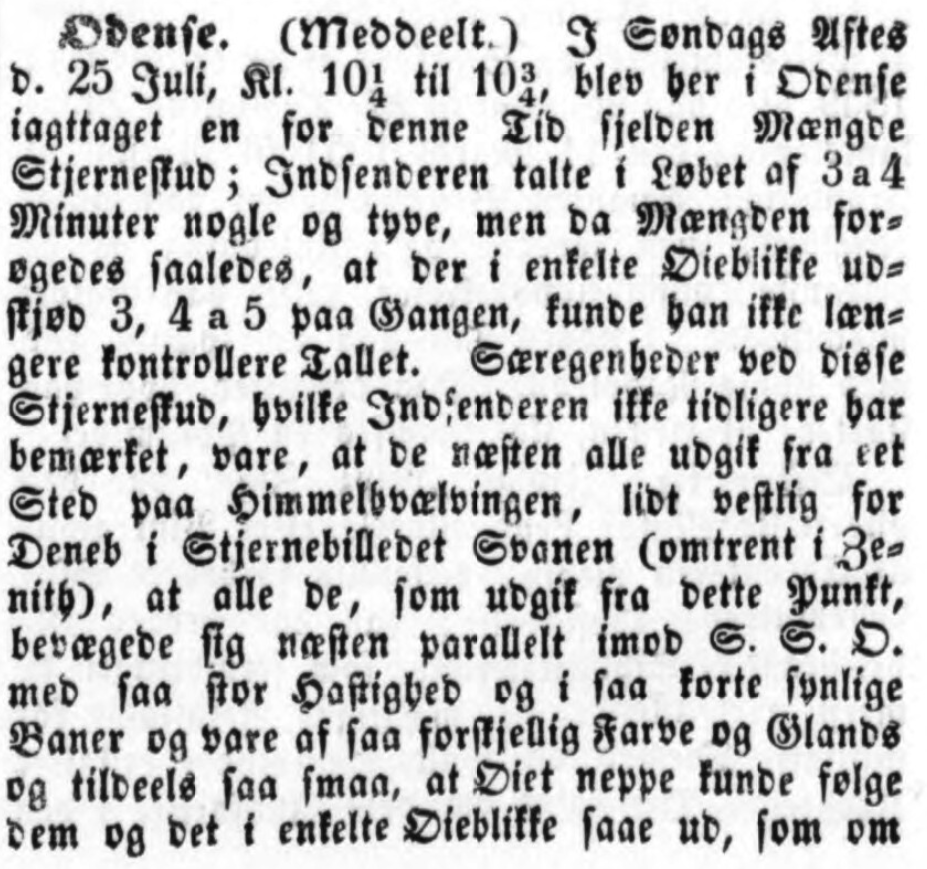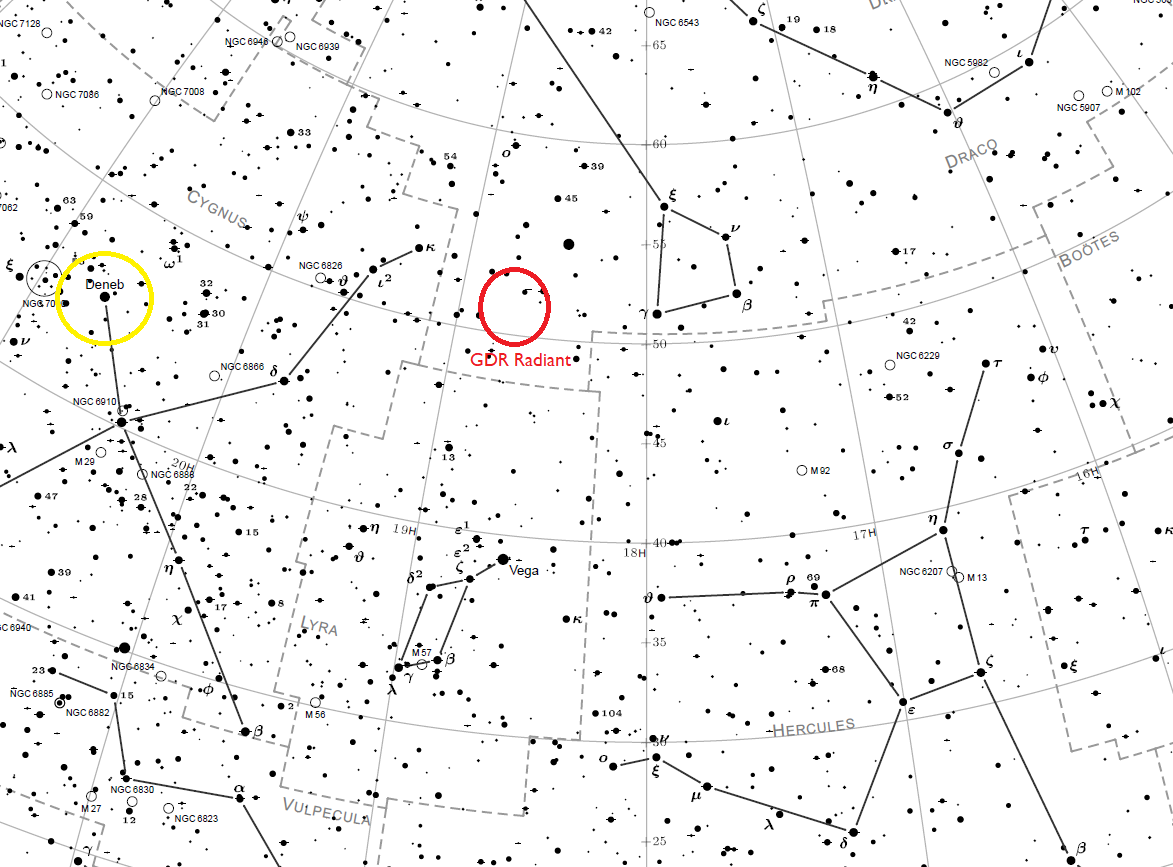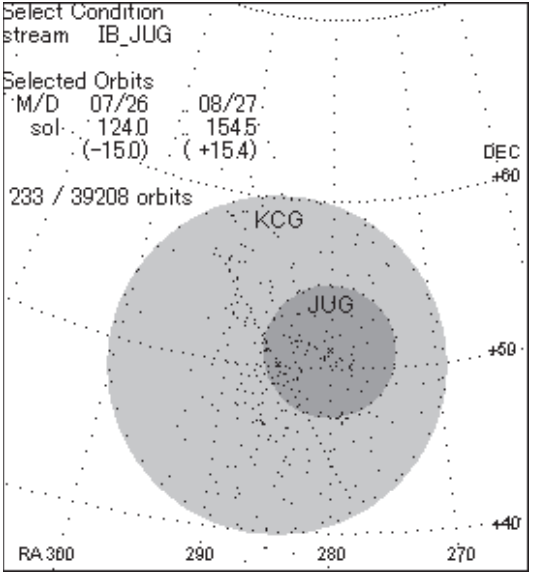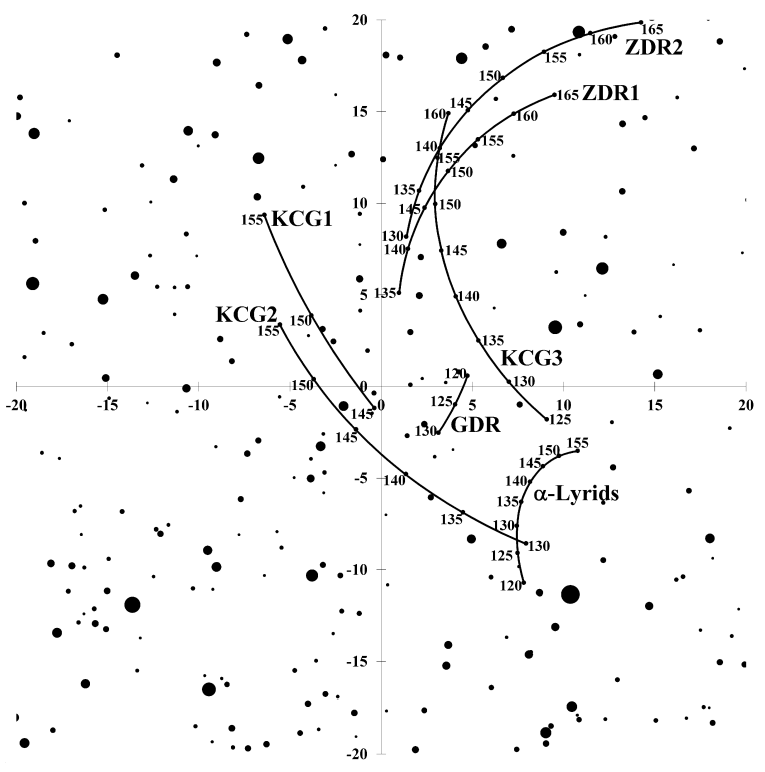By Holger Pedersen and Paul Roggemans
Abstract: A short report in a Danish newspaper describing a meteor outburst on 1852 July 25 between 22h15m and 22h45m local time, corresponding to solar longitude 125.12° (2000.0) from a radiant west of Deneb in the constellation Cygnus, resembles in duration, intensity, time of appearance and radiant location to the July gamma Draconid outburst observed by CAMS-BeNeLux between July 27, 23h56m and July 28 00h23m UT (λʘ = 125.13°).
Introduction
While checking old newspapers on the occurrences of astronomical events, the first author came across an interesting report published in the Danish journal “Fyens Stiftstidende” on 28. juli 1852 (Figure 1).

Figure 1 – Part from the original publication printed in the old typesetting.
The original article in Danish reads as: “Odense. (Meddelt.) I Søndags Aftes den 25de Juli, Kl. 10¼ til 10¾, blev her i Odense iagttaget en for denne Tid sjelden Mængde Stjerneskud: Indsenderen [i.e. message was sent as a letter] talte i Løbet af 3 a 4 Minuter nogle og tyve, men da Mængden forøgedes saaledes, at der i enkelte Øieblikke udskjød 3, 4 a 5 ad Gangen, kunde han ikke længere controllere Tallet. Særegenheder ved disse Stjerneskud, hvilke Indsenderen ikke tidligere har bemærket, vare, at de næsten alle udgik fra eet Sted paa Himmelhvælvingen, lidt vestlig for Deneb i Stjernebilledet Svanen (omtrent i Zenith), at alle de, som udgik fra dette Punkt, bevægede sig næsten parallelt imod S.S.O. med saa stor Hastighed og i saa korte synlige Baner og vare af saa forskjellig Farve og Glands, og tildeels saa smaa, at Øiet neppe kunde følge dem og det i enkelte Øieblikke saae ud, som om Stjernerne af 3die til 6te Rang i en liden Kreds foretog en Flytning en masse. Da man hidindtil har antaget de periodiske Stjerneskuds Tid kun at være fra 9de til 14de August samt 13de og 14de November og de her seete syntes for hyppige til at kunne henføres under de sporadiske, kunde denne lille notits maaskee, især dersom lignende Iagttagelser vare gjorte paa andre Steder, være af nogen Interesse.”
The translation from Danish to English reads: “Last Sunday evening, July 25, between 10:15 p.m. and 10:45 p.m., one – for the time of the year – unusual [unusually high] number of meteors were witnessed here in Odense: during some three to four minutes the contributor [the sender, the rapporteur] counted more than twenty [the Danish term usually means 22, 23, 24, or 25], but as the rate increased, so that in some instances three, four of five were emitted simultaneously, he could no longer be sure of the figure. Peculiarities of these meteors, which he has not noted prior, was, that almost all radiated from [were emitted from, emanated from] one single area [place, spot] on the celestial hemisphere, a little West from Deneb in the constellation The Swan (close to Zenith), that all those, which emitted from this point moved in almost parallel tracks towards SSE, with so great speed, and in so short tracks, and were of such different hue and brightness, and partially [to some extent] so small, that the eye could hardly follow them, and at some instances it appeared as if stars of 3rd to 6th magnitude in a small area [an area confined by a ring-like perimeter] moved ‘en masse’ [italics]. Since until now, the assumption has been that intervals of periodic [i.e. annually occurring] meteors were exclusively from August 9 to 14, and November 13 and 14 – and the here witnessed, seem too frequent to be referred to the sporadics – perhaps this little notice could – if similar observations are made elsewhere – be of some interest [i.e. to science]”.
Square brackets are the comments, alternatives suggested by the first author. At least eight other Danish newspapers copied the report, but adding no info. The Norwegian, Swedish and German newspaper archives were searched, but no similar report could be found.
July gamma Draconids outburst?
The report clearly describes a meteor outburst at an unusual time of the year not related to any known annual meteor shower like the Perseids or Leonids in the 19th century. The author gives a pretty precise hint where to look for the radiant: west of Deneb or alpha Cygnii near the zenith in Denmark on 1852 July 25 around 22h30m local time. The time of appearance corresponds to λʘ = 125.12° (epoch 2000.0).
Looking for possible associations with known meteor showers, the July gamma Draconids (GDR#184) appear to be a most likely candidate. This meteor shower produced a meteor outburst in 2016 at λʘ = 125.13° from a radiant position at α = 279.9° and δ = +50.5°, which is about 20° west from Deneb and near the zenith at the time mentioned for Denmark (Figure 2).

Figure 2 – Star map with the GDR#184 radiant marked in red, 20° west of Deneb marked in yellow.
What do we know about this shower?
Pulat Babadzhanov (1963) is considered to be the first who mentioned this radiant at α = 278.5° and δ = +48.8° as an unknown meteor shower based on 4 photographed meteors recorded between June 1957 and December 1959 at two stations of the Institute of Astrophysics of the Academy of Sciences of Tadjikistan. He refers to a nearby radiant at α = 279° and δ = +55° which was listed in a Russian Astronomical Calendar by Maltsev (1930), but the authors were unable to verify this reference.
It is strange that this shower does not appear in the radiant catalogue compiled by W.F. Denning (1899), apart from one unverified entry with a radiant at α = 285° and δ = +52° observed by Konkoly (Hungary) during July 26–29 in 1875 listed in this work. The absence in Dennings’s work, who systematically mapped meteor radiants from visual observations could be explained by its short-lived periodic outbursts. In the past most meteor shower outbursts were simply missed.
Alexandra Terentjeva listed a meteor shower with the name 13-Lyrids (Terentjeva, 1966; 2017, see pages 82 and 107 for shower entry 102), which corresponds to the current day known July gamma Draconids.

Figure 3 – The identification of the July gamma Draconids distinguished from the kappa Cygnid complex by SonotaCo (credit SonotaCo).

Figure 4 – The number of orbits identified as GDR#184 meteors in function of the solar longitude (credit CAMS, Holman & Jenniskens).
Some sources refer to Cook’s working list of meteor showers (Cook, 1973) with the o Draconids assumed to correspond to GDR#184, but the original publication by Cook et al. (1973b) clearly shows that this shower was based on only three isolated photographed meteors recorded on 6 and 16 July 1953 and 24 July 1952 all of which were very likely unrelated sporadic events, or perhaps early appearances of the kappa Cygnid complex. In the 1970ies until beginning of the 21st century meteor observers identified meteor activity from this area of the sky as the kappa Cygnid complex.
The meteor shower catalog based on 2007–2008 SonotaCo meteor orbits is in fact the very first publication that mentioned the July gamma Draconids based on 22 orbits from a radiant at α = 280.1° and δ = +51.1° with a maximum at λʘ = 125.3° (SonotaCo, 2009). This cluster with 22 radiants was extracted from the diffuse radiant area identified as kappa Cygnids (Figure 3) and was initially added to the IAU MDC Working List of Meteor Showers as JUG#344. Later it was recognized as identical to the GDR#184 entry and listed as GDR#184 while JUG#344 was removed from the list.
The GDR#184 meteor shower was soon confirmed by CAMS observations in July 2011 with a mean radiant at α = 279.6° and δ = +50.4° (Holman and Jenniskens, 2012). The number of occurrences in function of time or solar longitude shows a very sharp activity profile at λʘ = 125°, see Figure 4.

Figure 5 – The radiant drift of different components within the kappa Cygnid complex (credit Masahiro Koseki).
The availability of sufficient numbers of meteor orbit data made it possible to resolve the composition of the kappa Cygnid complex into separate branches with the July gamma Draconids as a distinct meteor shower. Masahiro Koseki (2014) analyzed and resolved the different components and distinguished the July gamma Draconids as group A in his study. The map with the radiant drift (Figure 5) shows the position of the GDR radiant very well west of Deneb. The GDR meteor shower was also described in Masahiro’s work on 12 years of SonotaCo data (Koseki, 2021, see page 135).
The July gamma Draconids surprised observers with an outburst in 2016 during the night of July 27-28 with a sharp maximum between July 27, 23h56m and July 28 00h23m UT (λʘ = 125.13°). About half of all 126 single-station detected meteors, typically about +2 magnitude bright, radiated from this shower’s radiant, as did 5 out of 9 multi-station meteors during this partly cloudy night. Beyond CAMS-BeNeLux this outburst was also confirmed by the meteor radar CMOR in Canada and different forward scatter meteor observers (Roggemans, 2016). The meteor shower characteristics were also described by Peter Jenniskens (2023).
Conclusions
The July gamma Draconids which produced a short-lived outburst in 2016 are the most likely source for a similar event described in a Danish newspaper in 1852. The timing corresponding to the same solar longitude and the location of the point of radiation at the zenith, west of Deneb, corresponds with the known meteor shower of the July gamma Draconids.
References
Babadzhanov P. (1963). “Orbital elements of photographic meteors”. Smithsonian Contributions to Astrophysics, 7, 287–291.
Cook A.F. (1973a). “A Working List of Meteor Streams”. In, Curtis L. Hemenway, Peter M. Millman, and Allan F. Cook, editors, Evolutionary and Physical Properties of Meteoroids, Proceedings of IAU Colloq. 13, held in Albany, NY, 14-17 June 1971. National Aeronautics and Space Administration SP 319, pages 183–192.
Cook A.F., Lindblad B.A., Marsden B.G., McCrosky R.E. and Posen A. (1973b). “Yet another stream search among 2401 photographic meteors”. Smithsonian Contributions to Astrophysics, 15, 1–5.
Denning W.F. (1899). “General catalogue pf the radiant points of meteoric showers and of fireballs and shooting stars observed at more than one station”. Memoirs Royal Astronomical Society, 53, 202–293.
Holman D. and Jenniskens P. (2012). “Confirmation of the July Gamma Draconids (GDR, IAU #184)”. WGN, Journal of the International Meteor Organization, 40, 36–41.
Jenniskens P. (2023). Atlas of Earth’s Meteor Showers. Elsevier, USA. Pages 192–193.
Koseki M. (2014). “Various meteor scenes II: Cygnid-Draconid Complex (κ-Cygnids)”. WGN, Journal of the International Meteor Organization, 42, 181–197.
Koseki M. (2021). “The activity of meteor showers recorded by SonotaCo Net video observations 2007–2018”. eMetN Meteor Journal, 6, 91–246.
Roggemans P. (2016). “Outburst of July gamma Draconids”. eMetN Meteor Journal, 1, 80–81.
SonotaCo (2009). “A meteor shower catalog based on video observations in 2007–2008”. WGN, Journal of the International Meteor Organization, 37, 55–62.
Terentjeva A. K. (1966). “Minor meteor streams”. In Collection of works ‘Meteor Investigation’, no. 1, from series ‘Investigation Results According to International Geophysical Projects’, Moscow. Nauka, pages 62–132. (In Russian).
Terentjeva A. (2017). “A meteor stream study of 1966”. eMetN Meteor Journal, 2, 95.

